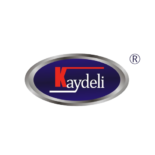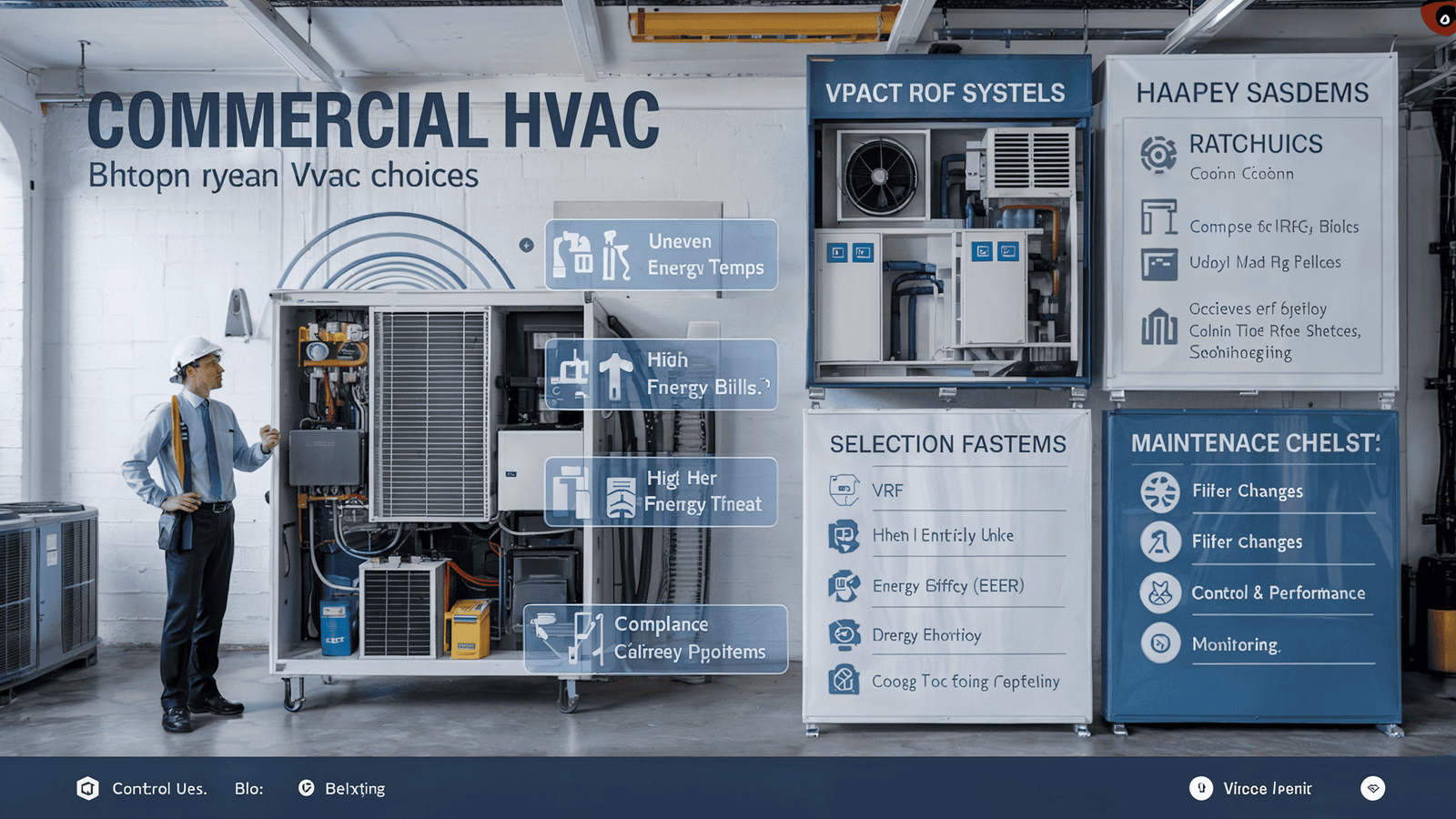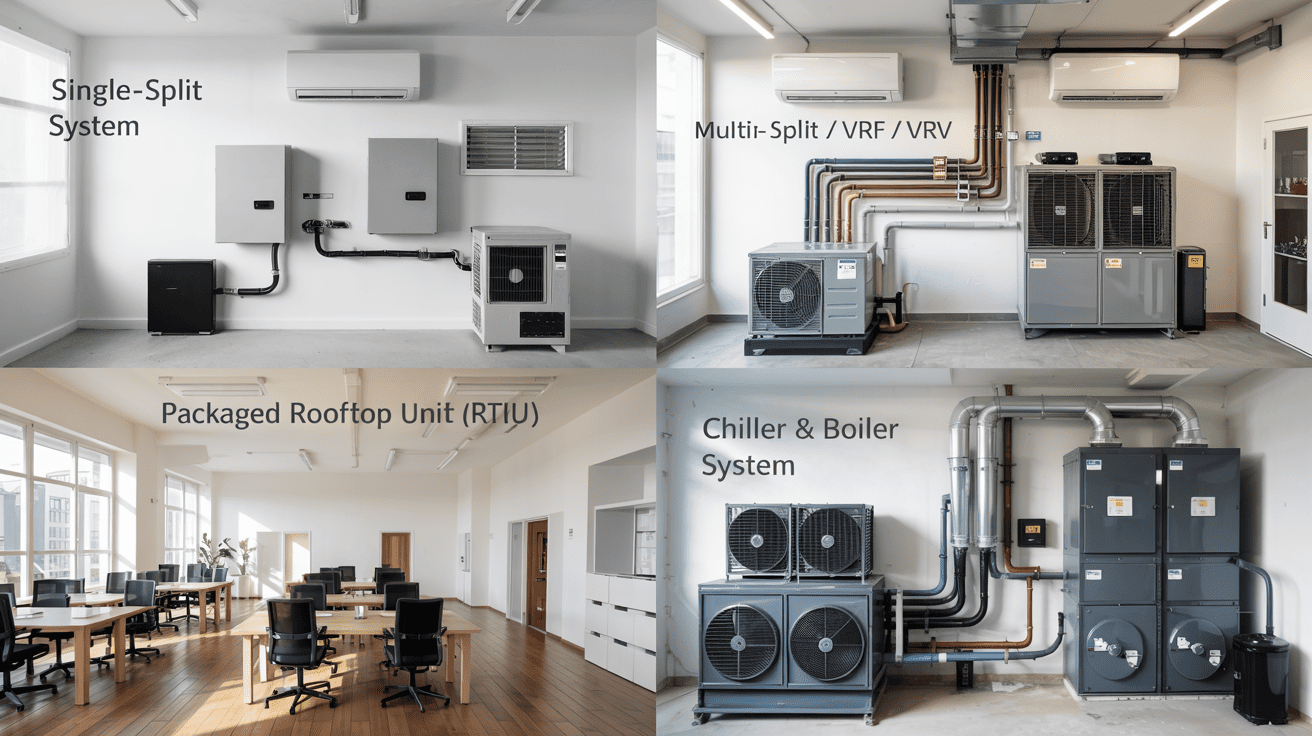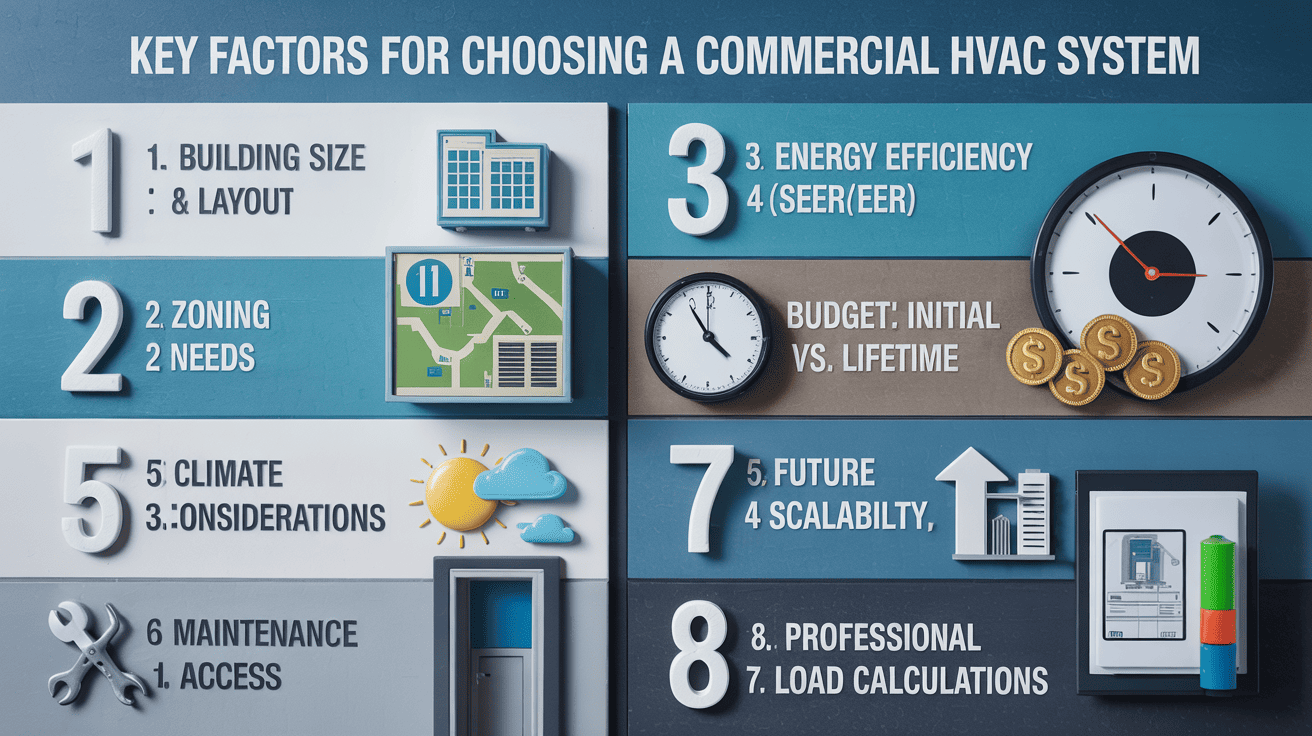Struggling with uneven temperatures and high energy bills in your large building? Unsure how complex HVAC systems manage it all effectively? Find the answers right here.
Commercial HVAC systems, ranging from split systems to large chiller plants, use tailored designs (like VRF for zoning or RTUs for open spaces) and robust components combined with ductwork or piping and controls to efficiently distribute conditioned air efficiently, ensuring consistent comfort and air quality throughout diverse commercial environments.
Understanding these robust systems is essential for managing comfort and operational costs in any significant commercial space. They operate on different principles and scales compared to residential units. Let’s delve into the specific types available and how they are selected and maintained for optimal performance. Read on to gain a clearer picture of commercial climate control.
What Are the Main Types of Commercial HVAC Systems Available?
Feeling lost in the jargon of commercial HVAC options like VRF, RTU, or Chillers? Choosing incorrectly can lead to wasted energy and unhappy occupants. Let’s clarify the primary system types.
Key commercial HVAC types include Single-Splits (small zones), Multi-Splits/VRF/VRV (flexible zoning), Packaged Rooftop Units (RTUs – common for low-rise), and Chiller/Boiler systems (large facilities), each suited to different building sizes, needs, and budgets.
Selecting the most suitable system is a critical decision with long-term implications. As someone who regularly discusses temperature control solutions with clients at Kaydeli, I’ve seen firsthand how matching the system type to the application saves money and headaches. Let’s break down the standard options based on your provided details, exploring their strengths and weaknesses to help you understand where each fits best.
Exploring the Spectrum of Commercial HVAC Solutions
The world of commercial HVAC isn’t one-size-fits-all. The technology scales dramatically from small shops to massive complexes. Single-Split Systems are the entry point, much like their residential counterparts, but often more robust. They connect one outdoor unit to one indoor unit, making them cost-effective and simple to install for a single, defined area like a small retail store or an individual office. Their main drawback is scalability; a separate system for each zone isn’t practical for larger, multi-room buildings. Moving up, Multi-Split Systems offer more flexibility. A single outdoor unit can power several indoor units, allowing different temperature settings in various rooms or zones. This is a step up for medium-sized spaces needing zoned control.
A more advanced version of the multi-split concept is Variable Refrigerant Flow (VRF)1 or Variable Refrigerant Volume (VRV) Systems. These are highly sophisticated and energy-efficient. One outdoor unit can serve many indoor units, and the system intelligently adjusts the amount of refrigerant sent to each one based on real-time demand. This precision allows for simultaneous heating and cooling in different zones, often recovering heat from cooling areas to warm others, boosting efficiency significantly. VRF systems provide exceptional comfort and savings in office buildings and hotels, though their higher upfront cost and complex installation require specialized technicians.
For many low-rise commercial buildings like big-box retail stores or warehouses, Packaged Rooftop Units (RTUs) are standard. All essential components (compressor, condenser, evaporator, fans, and often heating elements) are housed in a single cabinet on the roof, saving interior space. They connect to ductwork to distribute air. While convenient and relatively easy to maintain due to accessibility, they typically serve large single zones and might offer less granular control than VRF. Packaged Systems generally refer to these all-in-one units, whether rooftop or ground-mounted, suitable for medium spaces where simplicity is valued, though potentially less efficient for complex needs.
At the most enormous scale, we find Chilled Water Systems2 (Chillers) paired with Boiler Systems for heating. A central chiller plant cools water, which is pumped through pipes to air handling units (AHUs) distributed throughout the building. Air blown over coils filled with chilled water cools the space. Boilers provide hot water for heating through the same or separate coils in the AHUs. These systems are the workhorses for huge facilities like hospitals, universities, airports, and large industrial plants, for which Kaydeli often supplies chillers. They offer immense capacity, high efficiency potential (especially with heat recovery), excellent zoning capabilities via individual AHUs, and long lifespans. However, they have the highest initial investment and require dedicated plant room space and skilled maintenance.
| System Type | Ideal Use | Pros | Cons |
|---|---|---|---|
| Single-Split | Small shops, individual offices | Cost-effective, simple install | Limited to single zone, not scalable |
| Multi-Split | Medium spaces, zoned areas | Flexible zoning, fewer outdoor units than multiple single-splits | Higher cost than single-splits, moderate complexity |
| VRF/VRV | Medium-Large buildings, diverse needs | High efficiency, precise zoning, simultaneous heating/cooling | High initial cost, complex installation/maintenance |
| Packaged RTU | Low-rise retail, warehouses, large zones | Space-saving (roof), often simpler install/maintenance | Limited zoning, efficiency varies, roof access needed |
| Chilled Water/Boiler | Extensive facilities, complex buildings | High capacity & efficiency, excellent zoning, long lifespan | Very high initial cost, requires plant room, complex maintenance |
| Packaged (General) | Small-Medium spaces, simpler applications | Compact, often cost-effective upfront, simpler installation | Can be less efficient for large/multi-zone needs |
Understanding these core differences is the foundation for making an informed choice.
How Can Businesses Choose the Right HVAC System for Their Building?
Feeling uncertain about which HVAC system truly fits your commercial property’s needs? A mismatch can lead to years of discomfort and excessive energy spending. Let’s navigate the key selection factors.
Choosing the right commercial HVAC involves a detailed analysis of building size/layout, zoning needs, energy efficiency targets (SEER/EER), budget (initial vs. lifetime), climate, maintenance access, and future scalability, ideally guided by professional load calculations.
Selecting the optimal HVAC system is a strategic decision that impacts everything from employee productivity to the bottom line. It goes far beyond just comparing price tags. In my role, helping clients find the right Kaydeli solution, we always emphasize a holistic approach. Let’s break down the critical factors you need to weigh, incorporating the insights you gathered.
Matching the System to the Space and Use
The physical characteristics of your building are paramount. Building Size and Layout dictate the required capacity and distribution method. A sprawling warehouse needs a different approach than a multi-story office building with numerous private offices and meeting rooms. Ceiling height affects air volume, while factors like insulation quality, window type, and building orientation significantly impact the heating and cooling load – the energy needed. You must also consider the Zoning Requirements. Does the entire building need one uniform temperature, or do different areas (server rooms, conference rooms, open-plan offices) require independent control? Systems like VRF/VRV or Chiller/AHU setups excel at granular zoning, whereas RTUs or single-splits are better suited for larger, uniform zones.
Balancing Budget, Efficiency, and Climate
Budget is always a constraint, but it’s crucial to differentiate between upfront cost and long-term operational expenses. While Single-Split or basic Packaged Systems might have a lower initial purchase price, more sophisticated systems like VRF/VRV atau Chilled Water systems, despite their higher initial investment, often deliver substantial savings over their lifespan due to superior Efisiensi Energi. Look for high SEER (Seasonal Energy Efficiency Ratio) and EER (Energy Efficiency Ratio) ratings for cooling, and AFUE or HSPF for heating. Your local Climate and Location heavily influences the choice; prioritize cooling capacity in hot areas and robust heating in cold regions. Don’t forget to check for local energy codes and potential rebates for high-efficiency equipment, which can offset some initial costs.
Planning for Maintenance and the Future
Consider the practicalities of Maintenance and Support3. Are parts readily available? Are qualified technicians in your area familiar with the chosen technology (essential for complex systems like VRF or chillers)? Accessibility for maintenance, like needing roof access for RTUs or space for a chiller plant, should be factored in. Finally, think about Future Scalability4. If you anticipate expanding the building or changing its use, will the HVAC system be able to adapt? VRF systems, for instance, are known for their modularity, allowing relatively easy expansion compared to other types.
Ultimately, the best approach involves professional consultation. An experienced HVAC contractor can perform accurate load calculations using industry standards (like those from ASHRAE – American Society of Heating, Refrigerating and Air-Conditioning Engineers). They will assess all these factors – building specifics, usage patterns, budget, climate – to recommend and design a correctly sized and configured system, avoiding the pitfalls of oversized systems (inefficient, poor humidity control) or undersized ones (unable to maintain comfort). This expert guidance is invaluable for making a sound investment.
What Are the Key Maintenance Tips for Commercial HVAC Longevity?
Dreading sudden HVAC failures disrupting your business and leading to expensive emergency calls? Consistent maintenance is the key to reliability and avoiding premature replacement. Let’s outline essential upkeep practices.
Essential commercial HVAC maintenance includes frequent filter changes, annual coil cleaning, drain line checks, ductwork inspections, regular professional tune-ups (biannually), and monitoring system controls and performance to ensure efficiency and a long lifespan (15-20 years).
A commercial HVAC system represents a significant capital investment, and protecting that investment requires proactive care. Based on my experience with industrial equipment where downtime is critical, preventative maintenance isn’t just recommended; it’s essential for ensuring reliability, efficiency, and reaching the system’s expected lifespan of 15-20 years or more. Neglect leads to higher energy bills, poor indoor air quality, unexpected breakdowns, and costly repairs. Let’s detail the crucial maintenance steps by drawing from your provided list.
Foundational Maintenance Tasks
The most straightforward yet most impactful task is Regular Filter Replacement5. Dirty filters choke airflow, forcing fans to work harder, increasing energy use, and potentially causing component failure. They also degrade indoor air quality. Filters should be checked monthly and replaced or cleaned every 1-3 months, depending on the operating environment and filter type. Equally important is keeping heat exchange surfaces clean. Clean Coils and Components annually – both indoor evaporator and outdoor condenser coils. Dirt buildup acts like insulation, drastically reducing efficiency. Also, ensure the condensate drain line is clear to prevent water backup, potential property damage, and mold growth. For systems with ductwork, Inspect Ductwork periodically. Leaks in supply or return ducts can waste 20% or more of conditioned air, sending it into walls or ceilings instead of occupied spaces. Seal leaks with mastic or metal tape and ensure ducts are adequately insulated.
Professional Checks and System Monitoring
While filters are easy for facility staff, comprehensive care requires expertise. Schedule Scheduled Professional Inspections at least twice yearly (spring for cooling, fall for heating). Certified technicians should perform a thorough check-up: inspecting electrical connections, measuring refrigerant levels (critical for efficiency and compressor health), checking motors and Lubricating Moving Parts like bearings, inspecting belts for wear and tension, cleaning burners or heat exchangers, and verifying safety controls. They can spot developing issues before they become major failures. Monitor Thermostats and Controls – ensure they are calibrated correctly. Upgrading to programmable or smart thermostats linked to a Building Management System (BMS) allows for optimized scheduling based on occupancy and provides valuable data for Monitoring System Performance. Tracking energy usage and responding quickly to anomalies (strange noises, temperature fluctuations, rising bills) is key.
Empowering Staff and Planning Ahead
Finally, Train Staff – at least the facility manager – on basic system operation, how to spot trouble signs (odors, noises, airflow issues), and who to call. Emphasize not overriding settings unnecessarily, which can unbalance the system. The "Pro Tip" is excellent advice: establish a preventive maintenance contract with a qualified and reputable HVAC service company. This ensures consistent care, often provides priority service during peak seasons or emergencies, and helps budget maintenance costs. Consistent, planned maintenance is the best strategy to maximize the return on your significant HVAC investment.
Kesimpulan
Choosing the right commercial HVAC system and maintaining it diligently are crucial for building comfort, efficiency, and longevity. Informed selection and proactive care ensure optimal performance and prevent costly issues down the line.
-
Learn about VRF technology to see how it optimizes energy use and comfort in diverse commercial spaces. ↩
-
Discover the applications and benefits of Chilled Water Systems for large facilities and their efficiency in climate control. ↩
-
Explore this resource to understand essential practices for maintaining HVAC systems, ensuring reliability and longevity. ↩
-
Learn about the importance of scalability in HVAC systems to accommodate future building changes and expansions. ↩
-
Discover why regular filter replacement is crucial for HVAC efficiency and indoor air quality, helping to extend system lifespan. ↩






